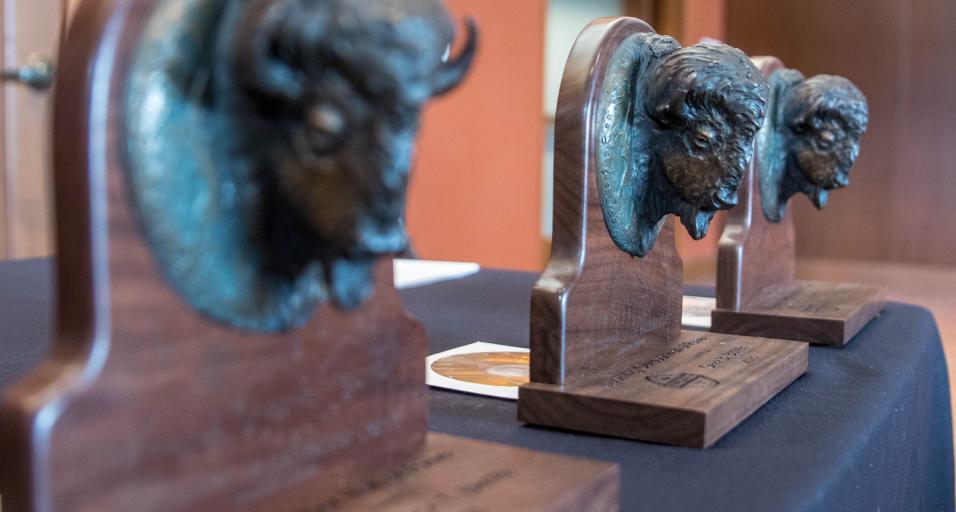Five individuals who made significant contributions to the Wyoming outdoors will be inducted into the Wyoming Outdoor Hall of Fame this March. The Hall of Fame honors individuals, both living and posthumously, who have made significant, lasting, lifetime contributions to the conservation of Wyoming’s outdoor heritage. The induction ceremony will take place in Cody at the Buffalo Bill Center of the West on Friday, March 22.
Mark Haroldson, Dr. John W. Scott (posthumously), Glen F. Cole (posthumously) and Orrin and Lorraine Bonney (posthumously) will join 58 past inductees. The Wyoming Outdoor Hall of Fame was established in 2004 by then Gov. Dave Freudenthal to celebrate individuals who have shown leadership and vision related to conserving wildlife, habitat or our heritage of hunting and fishing. Tickets are available online for the induction ceremony.
Mark Haroldson has spent more than 40 years working on the conservation of bears and studying the ecology of the Yellowstone area grizzly bear population with 36 of those working for the United States Geological Survey. Haroldson is regarded as a pioneer and worldwide expert in grizzly bear research, credited with furthering the understanding of the ecology of the Yellowstone area bears. With a geneticist, Haroldson developed a genetic fingerprint unique to the Yellowstone grizzly population that allows law enforcement to determine a deceased bear’s population origin, a tool that often aides in poaching cases. Haroldson’s data and analysis of grizzly bear population demographics at the fine-scale level is unparalleled at more than 1 million radio collar locations, hundreds of records of grizzly bear mortalities, litter sizes, ages of first reproduction, reproductive intervals, reproductive senescence, morphological data and human-bear conflicts. Haroldson pioneered the development of safe and humane capture and immobilization techniques for the handling of grizzly bears and those are used by managers and researchers across the world. Haroldson contributed to the development of laws, regulations, wildlife and land use policies, and management programs in Wyoming, Montana, Idaho and in Yellowstone and Grand Teton National Park, in addition to surrounding public and private lands. Haroldson received the highest honor awarded by the U.S. Department of Interior, the Distinguished Service Award in 2018. He resides in Bozeman, Montana, with his wife Cecily and has a son, Zane. He is currently the supervisory wildlife biologist for the USGS Interagency Grizzly Bear Study Team.
Dr. John W. Scott was an educator, researcher and administrator of wildlife conservation. Dr. Scott moved to Laramie, Wyoming, in the fall of 1913 to work as a professor of zoology and a research parasitologist at the University of Wyoming. He would eventually lead the zoology department as chair and department head, the director of the pre-medical course, and oversaw the creation of a bachelor of science degree in conservation and game management in 1939. During his tenure, Dr. Scott was called upon in 1935 by Gov. Leslie A. Miller to chair a committee to revamp Wyoming’s wildlife laws. This came as a result of measures to move away from political interests controlling wildlife conservation efforts and to separate conservation departments from direct interference from governors and state legislators. In 1925, state legislation created a non-partisan, six-member wildlife commission — the Wyoming Game and Fish Commission that exists today. Dr. Scott was one of eight delegates including Gov. Miller, from the state of Wyoming who attended the North American wildlife conference in Washington D.C. in 1936. This conference was called by President Franklin Roosevelt. The meeting was the genesis for the formation of the General Wildlife Federation; now the National Wildlife Federation. Soon after in 1937, Dr. Scott was appointed as the first secretary of the Game and Fish Commission under the new code in February 1937. He had not applied for the position but was selected to lead the department’s transition. Dr. Scott took a two-year leave of absence from the University of Wyoming to initiate this transition. He removed political appointees, formed an investigation division to conduct wildlife research, and provided a fair method of reimbursement for warden vehicle expenses. Returning to the university, he continued his teaching and mentorship, and was widely regarded as an influential mentor to some of the Wyoming’s leading conservationists including James R. Simon, a former Hall of Fame inductee. Dr. Scott died in 1956.
Glen F. Cole was a research scientist in both Grand Teton and Yellowstone National parks whose work profoundly impacted the management of bear, ungulate and trout populations. His career in Wyoming began in 1962, working as a supervisory wildlife research biologist with the National Park Service for five years in Grand Teton, and then in Yellowstone until 1976. During his tenure, Cole was a driving force behind the development of bear management programs in Yellowstone aimed at restoring wild, free-ranging grizzly and black bears and reducing bear injuries to park visitors. He closed garbage dumps in and near the park and improved other food storage regulations in the backcountry as well as removing problem bears. The program also led to the establishment of the Interagency Grizzly Bear Study Team. Cole also worked on ungulate management. In Grand Teton, he worked with Game and Fish and the National Park Service on elk management strategies, moose ecology and other studies on elk, bison and pronghorn populations within the park. Not limited to mammals, Cole also worked to stabilize fluctuating water levels on the Snake River to minimize impacts to native fish and aquatic environments. In Yellowstone, Cole worked in collaboration with then Superintendent Jack Anderson to reduce limits on native fish and promote “catch and release” for wild trout, while encouraging non-native fish harvest. In 1976, Cole worked as a supervisory research biologist in Voyageurs National Park Minnesota until his retirement in 1988. He died Aug. 19, 2004.
Orrin and Lorraine Bonney climbed Wyoming’s peaks and authored 19 climbing and hiking guidebooks of Wyoming’s wilderness. The couple met in the early 1950s and lived in Houston, but summered in Jackson Hole, where their love of Wyoming’s Teton and Wind River ranges inspired their outdoor publications. In 1960, they moved to Wyoming to a cabin on the edge of Grand Teton National Park and authored their seminal work, “Guide to the Wyoming Mountains and Wilderness Areas”, republished twice in 1965 and 1977. Portions of the guidebook were later published separately and became known as the hiking and climbing “bible” for Wyoming mountaineers. Following Orrin’s death in 1979, the book, The Grand Controversy, was published after Orrin’s death by Lorraine in 1992. The Bonney’s actively fought for the creation of the Wyoming Wilderness Act. To commemorate their impacts, the Federal Board of Geographic names announced in 1983 the Continental Divide pass in the Wind River Range connecting Titcomb Valley and Dinwoody Valley at the base of Gannett peak would be named Bonney Pass. The pass is the most commonly used access by climbers attempting to summit Gannett Peak — Wyoming’s highest mountain. Orrin died in 1979 and Lorraine in 2016.
“Each of the inductees has not only made the outdoors a priority, but has consistently invested time, hard work and considerable personal resources into making Wyoming a better place,” said Scott Talbott, director of the Wyoming Game and Fish Department. “We congratulate the inductees and their families. Game and Fish and our partners look forward to honoring them in March, and I hope you will join us.”
The Wyoming Game and Fish Department invites the public and partners to come and celebrate this year’s class and support conversation. Tickets and information regarding sponsorship opportunities are available online. For more information contact Sara DiRienzo at (307) 777-4540.
Five conservationists selected for 2019 Wyoming Outdoor Hall of Fame
Sara DiRienzo (307-777-4540)



